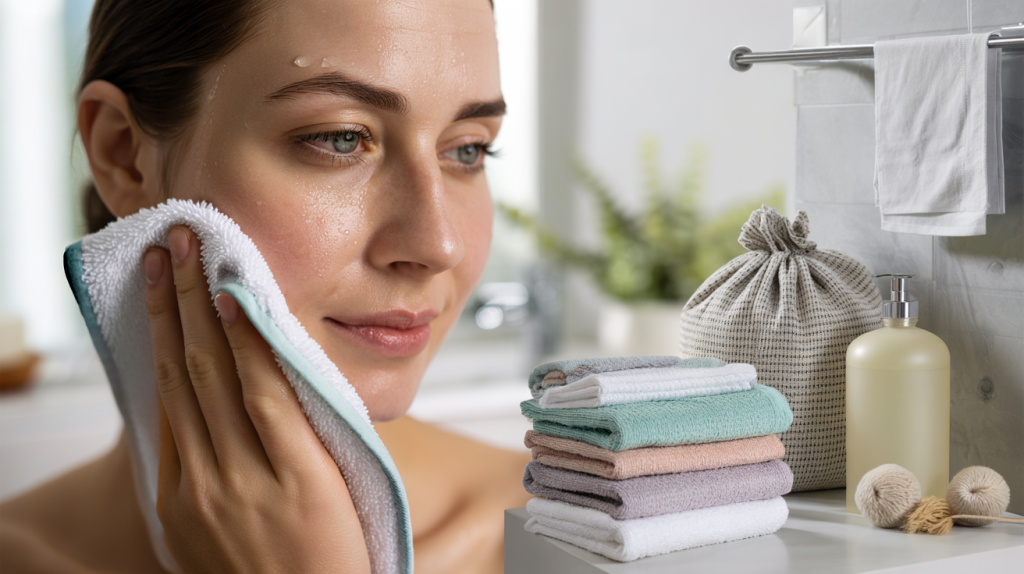Skin flares after cleansing often come down to two culprits : friction and lingering bacteria. That is why the serviette visage microfibre – a microfiber face towel – has turned into a quiet favorite in skincare routines. Its ultrafine fibers lift makeup, sunscreen, and sebum using just water, then pat skin dry without rough rubbing.
The hygiene angle matters. The American Academy of Dermatology Association reports that acne affects up to 50 million Americans every year, and using a clean towel each time you wash helps limit breakouts. Household textiles also collect microbes fast : a University of Arizona team led by Charles P. Gerba found coliform bacteria on 89 percent of tested kitchen towels and Escherichia coli on 25 percent in a widely cited study from 2011. In professional cleaning, the U.S. Environmental Protection Agency documented in 2002 that microfiber mops removed up to 99 percent of bacteria from hospital floors, while traditional cotton mops removed about 30 percent. Different setting, same principle : dense microfibers grip residues more effectively.
Microfiber Face Towel Basics : What It Does for Skincare
Microfiber is woven from extremely thin synthetic filaments that create a vast surface area with split ends. On skin, that structure hooks debris and excess oil, then releases it in the wash. The result feels simple : less scrubbing to get clean, less redness after.
People with sensitive or acne-prone skin notice the difference fastest. A soft patting motion does the drying, so the skin barrier stays calmer. Makeup wearers like the gentle lift on sunscreen and pigments during a second cleanse. Travelers like that microfiber dries quickly, which means fewer smells and less bacterial growth from a damp towel sitting around.
Cost per use tends to be low because microfiber washes well. Rotation helps as well : one clean towel per face wash, then into the laundry basket.
Common Towel Mistakes : Hygiene, Acne, Irritation
Reusing the same damp towel for days spreads microbes back to freshly cleansed skin. Sharing a face towel spreads them between people. Both habits show up later as clogged pores or new pimples in places that seemed calm yesterday.
Rubbing to feel “extra clean” backfires. The skin barrier hates friction. Redness after drying is a clue the towel did too much. A gentle press and pat gets the job done without microtears.
Laundry errors also hurt performance. Fabric softeners and dryer sheets coat fibers, which makes microfiber smear water rather than absorb it. Harsh heat can melt or warp filaments. People then blame the towel, when the wash cycle was the real problam.
How To Use a Serviette Visage Microfibre Daily
Simple habits keep the benefits consistent.
- Cleanse first : remove makeup and sunscreen with a balm or gentle gel, then rinse.
- Pat, do not rub : fold the towel, press, lift, repeat along the face and neck.
- One-and-done : use a fresh towel each cleanse if you have acne-prone or reactive skin, as the AAD recommends a clean towel to limit breakouts.
- Launder right : wash warm with fragrance-free detergent, no fabric softener, no dryer sheets. Tumble low or line dry.
- Rotate smart : keep a small stack so towels fully dry between uses, especially in humid bathrooms.
Care, Science et Real Results : What Studies Tell Us
The logic ties together. Acne thrives where oil, dead cells, and bacteria meet. Cleaner contact points make a difference, and towels are a daily contact point. The AAD’s prevalence figure – up to 50 million Americans each year – explains why small hygiene tweaks scale into visible results for many households.
The contamination data on household towels from the University of Arizona study highlights a reality at home : textiles collect microbes with normal use. That work assessed kitchen towels, not face towels, yet it shows why reusing damp cloth on clean skin is a weak link.
Microfiber’s strength in clinical cleaning has years behind it. The EPA’s hospital case study in 2002 documented major bacterial removal with microfiber systems without relying on harsh chemistry. On the face, a similar microfiber structure helps reduce the need for aggressive rubbing while lifting residue efficiently. People feel the effect as less tugging, fewer red patches after drying, and a calmer look the next morning.
For care and longevity, brands often recommand avoiding fabric softeners and high heat because they clog or distort the microscopic splits that do the work. That keeps absorbency high and minimizes odor build up between washes. If a towel starts to smear water or feels slick, a deep wash with a bit of baking soda or a microfiber-specific detergent usually resets performance.
The missing piece for many routines is consistency. A serviette visage microfibre is not a magic wand, but paired with a gentle cleanser and a clean-towel-each-time habit, it removes one avoidable trigger : friction and residue re-transfer. Small change, repeat daily, then let skin show the difference.
